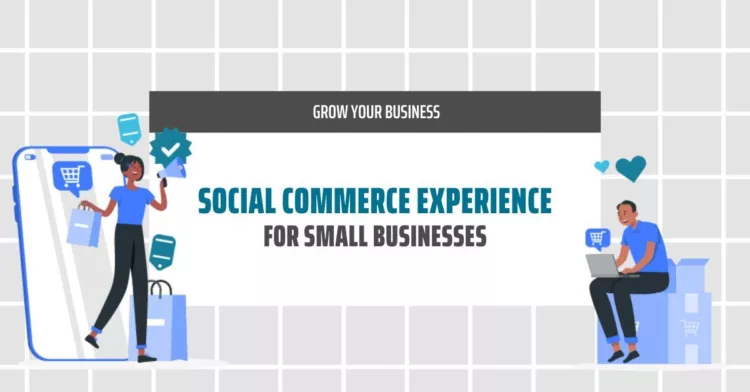The Importance of the Social Customer Experience to Small Businesses

As technology becomes more advanced, society is moving towards spending more and more time in virtual spaces. This includes, of course, social media platforms. And it’s not just personal interactions that happen here – increasingly, a lot of business is done on these channels, too.
If you run a small company and are looking to enhance your customer experience and gain more exposure, you should seriously look to social media as a tool to help you achieve that. By perfecting your social customer experience, in particular, you’ll be able to reap exceptional benefits from these platforms.
Want to know how, exactly? Keep reading.
What is a social customer experience?
The term ‘social customer experience’ describes the thoughts and feelings your customers have as they interact with your company’s social media accounts.
For example, let’s say you’ve crafted a fantastic social customer experience. This would mean that anytime your customers want to get in touch with you via social media, they know they’ll find what they’re looking for in a seamless, quick way that leaves them feeling satisfied.
They would also enjoy seeing your content on their chosen social media channels. Ideally, this would encourage them to purchase your products, or to become curious and learn more if they haven’t yet made a purchase with you.
So, in short, improving your social customer experience should revolve around optimising the customer experience across your social media channels.

Which social media platforms are included?
Generally speaking, you should aim for the kinds of social media spaces where members of your target demographics spend a lot of time. That means that in order to create a concrete list of social media sites to focus on, you’ll have to research those demographics.
With that said, there are some platforms that any business should establish a presence on.
These include major staples of the social media experience as a whole, like Instagram, Twitter, Pinterest, and TikTok. Facebook is another popular choice, alongside the Metaverse.
Why is it important to small businesses?
Typically speaking, small businesses will have fewer resources at their disposal than their medium and large-sized counterparts. This means they have to make every penny and every minute count.
In other words, a small business won’t be able to spread its outreach, marketing, and retention efforts out across loads of different channels, or invest in expensive ad programs. Thanks to its affordable, ubiquitous, and easy-to-navigate nature, the world of social media happens to be one of the best ways to craft, refine, and strengthen a small business’s social customer experience.

Top 5 reasons why social customer experience matters
It’s simple enough to claim that social customer experience ‘makes a difference’, but what does that really mean? Perhaps more importantly, why does it truly matter?
The following factors outline the huge impact that social customer experiences can have on your small business.
Brand identity
Your customers need to be able to take a single glance at any page or channel owned by you and recognise you straight away. This can only happen with a strong brand identity, which you can set up and reinforce using social media.
For example, let’s say that being witty and up-to-date with current events is part of your brand identity. You’d then want to make sure that your brand’s Twitter account is providing appropriately humorous responses to tweets about things happening in the world right now.
Your brand identity should also be reflected in the rest of your content beyond social media. For example, if you’re looking to secure a .ai tld (top-level domain), this should have a name that suits your business. The website should then be laid out and designed as per your brand style guidelines.
Lead generation
A company with a strong social media presence is going to have a much easier time drawing in new leads and getting them interested in new products, both of which are essential to growing your small business.
A good social customer experience, in fact, helps you show leads what they have to gain from becoming your customer. If they really enjoy interacting with your social media accounts, they’ll be far more likely to want to interact with your brand in other ways, too.
You can further optimise the lead generation process by using data pipeline tech to gather information on the kinds of leads that engage with your content.

Retention
Providing customers with more touchpoints that help them reach you is a great way to reduce churn and increase retention rates. This is especially true if customers don’t have to step outside of the digital spaces they’re already comfortable with in order to reach you.
By the same logic, setting up social media accounts on more platforms will help you keep more customers engaged, provided those new accounts contribute to an overall amazing experience for your customers.
Sales
A great social customer experience can only be forged by relying on a strong relationship between your business and its customers.
That same relationship helps you drive sales.
Your customers will keep coming back to your social media accounts if they’ve had good experiences, as well as when they trust you to meet their needs. That means that you’ll be able to use that connection to upsell or advertise new products directly to your audience.
Customer service
You may already run a couple of call service centres to support your customers’ needs, but how about adding social media to the mix, too?
If your customers know they can reach you via social media thanks to the excellent experiences you provide across these platforms, they’ll feel more comfortable asking for the support they need. This reduces frustration while also cutting down on overall waiting times, as the customers that prefer phone conversations will go straight to your call centres.

How to optimise your social customer experience
Next, we’ll be sharing some best practices you can use to ensure that the social customer experience you’re crafting is as polished as possible.
Focus on engagement
You can’t win people over nearly as quickly if you’re only expecting them to drop you a passive like here and there. Instead, consider putting emphasis on engagement and direct, live interactions.
A great example of this can be found in livestream shopping. This brings you revenue in the form of the streamer making purchases, while also drawing in new leads thanks to the stream’s viewers.
You can encourage this type of engagement by offering special deals or promotions to livestream shoppers.
Look to data
If you don’t yet have your own data warehouse, let this be your sign to get one.
Data is information, packaged in a format that can be processed easily and transformed into actionable insights.
When you gather data on your customers’ online preferences, you’re preparing yourself for making fact-backed plans and letting knowledge guide you instead of feelings or conjecture.
Expand your social media presence
It’s always a good idea to try and reach a larger audience, which you can easily do when you establish a presence on more sites.
Maybe you’ve already got a strong Instagram presence, but your company’s Facebook account only posts once a month or so. You can expand your presence in this scenario by putting more work into making your Facebook page a thriving hub of activity.
Alternatively, you can look into creating accounts on newer or less popular websites. The audiences there might be exactly what you’re searching for, after all.

Get feedback
Few people know more about your customers’ experience than those customers themselves, which is why it’s a great idea to ask for their opinions. You can do this by means of a survey or feedback form.
The more feedback you gather, the easier it will be to pinpoint your social customer experience strengths and weaknesses.
You’ll then be able to tailor that experience to the needs, preferences, and even requests of your customers more easily. Plus, you get to show them you value their opinions by implementing changes in your strategy to reflect their suggestions.
Keep an eye on trends
Despite the fact that they don’t always last for a long time, social media trends can be incredibly valuable to small businesses looking to boost their social customer experience.
Trends represent an online community coming together to participate in a particular activity, or to comment on a specific topic. If you time things right, you can ensure you’re able to join in with that activity or conversation, which means showing your customers that you care about the things they spend their time on.
Broader trends can also be indicative of the ‘Zeitgeist’ of the moment – or, to transliterate, the ‘spirit of the time’.
For example, if a topic like eco-friendliness repeatedly trends, that’s a good sign that your customers are invested in supporting the environment. You can use this information to help you adjust your approach to product design and marketing, so your focus reflects your customers’ preferences.
Final thoughts
Your social customer experience is all about providing the best possible experience to anyone who interacts with or even browses your company’s social media accounts.
It should be a vital part of your digital strategy, because social media looks set to continue to be hugely relevant to people’s lives.
As long as you’re able to meet customers there and create a seamless experience for them, you’ll have an excellent social customer experience on your hands in no time.
Author bio:
Pohan Lin is the Senior Web Marketing and Localizations Manager at Databricks, a global Data and AI provider connecting the features of data warehouses and data lakes to create lakehouse architecture. With over 18 years of experience in web marketing, online SaaS business, and ecommerce growth. Pohan is passionate about innovation and is dedicated to communicating the significant impact data has in marketing.Pohan has written for other domains such as Poptin and DashThis.
AI's Role in Tailoring Your Web Journey
What are MX Records and how to use them in 2024
Related articles:
